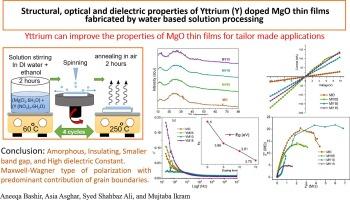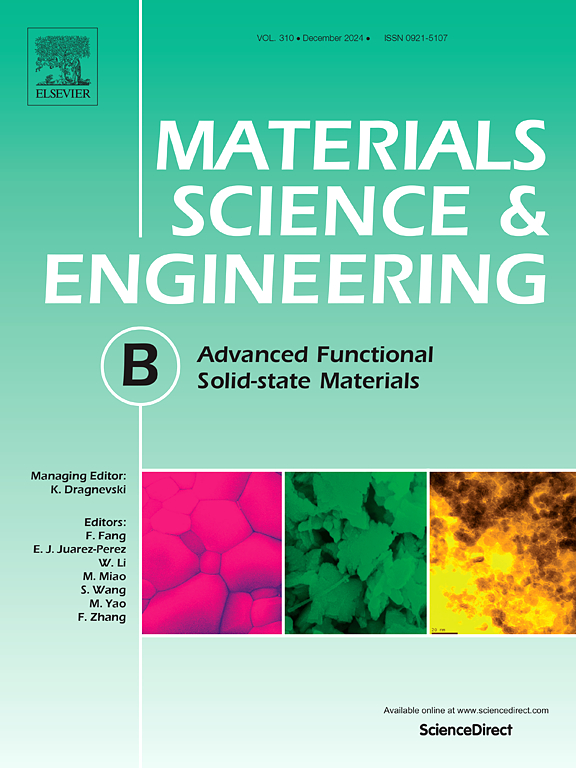通过水基溶液加工制造的掺钇 (Y) 氧化镁薄膜的结构、光学和介电特性
IF 3.9
3区 材料科学
Q2 MATERIALS SCIENCE, MULTIDISCIPLINARY
引用次数: 0
摘要
本文证实了一种生态水基溶液加工方法在制造氧化镁(MgO)薄膜时的高性能,该方法在 ITO 玻璃基底上掺入了不同含量的钇(Y)(0、05、10 和 15 原子%)。X 射线衍射图没有观察到混合相和次相,表明所有薄膜都是无定形的。傅立叶变换红外光谱(FTIR)显示出氧化物的特征峰,没有明显的杂质痕迹,而电离辐射X 分析则证实了沉积薄膜中的镁、O 和 Y 元素特征。扫描电子显微镜图像显示,随着 Y 掺杂水平的提高,表面形态从光滑变为不均匀的丝状晶粒,表面出现空隙。透射率增加,光带隙从 4.00 eV 下降到 3.75 eV。与原始氧化镁薄膜相比,折射率和消光系数都有所提高。氧化镁中激发的红色发光带波长约为 700 纳米。所有薄膜都表现出欧姆传导性,随着 Y 含量的增加,电阻率降低了一个数量级(∼103 Ωcm)。观察到介电常数(实数和虚数)、正切损耗、阻抗和电模量都与频率和掺杂剂密切相关。这些光谱与库普理论中的麦克斯韦-瓦格纳极化类型密切相关。分析进一步得出了晶界和非德拜弛豫现象的主要贡献。这些薄膜适用于低频电子应用。本文章由计算机程序翻译,如有差异,请以英文原文为准。

Structural, optical and dielectric properties of Yttrium (Y) doped MgO thin films fabricated by water based solution processing
This paper establishes the high performance of an ecological water-based solution processing in creating Magnesium oxide (MgO) thin films with various doping levels of Yttrium (Y) (0, 05, 10, and 15 atomic %), on ITO glass substrates. No mixed and secondary phases have been observed by XRD patterns revealing an amorphous nature in all the films. From FTIR, the characteristic peaks of oxides have been found with no significant traces of impurities while EDX analysis has confirmed the elemental signatures of Mg, O, and Y in the deposited films. The SEM images have shown a change in the surface morphology from smooth to inhomogeneous filament type grains having voids in the surface as the Y doping level is increased. The transmittance is increased, while the optical band gap is decreased from 4.00 to 3.75 eV. The refractive index and extinction coefficient are found improved as compared to pristine MgO film. The red luminescence band excited in MgO is observed around 700 nm. All the films exhibit ohmic conduction with resistivity decrease by an order of magnitude (∼103 Ωcm) as the Y content increases. Strong dependence of the dielectric constant (real and imaginary), tangent loss, impedance and electric modulus on both the frequency and dopant has been observed. The spectra are well referred to the Maxwell-Wagner type of polarization of Koop’s theory. The analysis further leads to the predominant contribution of grain boundaries and a non-Debye relaxation phenomenon. The films are found suitable for low frequency electronic applications.
求助全文
通过发布文献求助,成功后即可免费获取论文全文。
去求助
来源期刊

Materials Science and Engineering: B
工程技术-材料科学:综合
CiteScore
5.60
自引率
2.80%
发文量
481
审稿时长
3.5 months
期刊介绍:
The journal provides an international medium for the publication of theoretical and experimental studies and reviews related to the electronic, electrochemical, ionic, magnetic, optical, and biosensing properties of solid state materials in bulk, thin film and particulate forms. Papers dealing with synthesis, processing, characterization, structure, physical properties and computational aspects of nano-crystalline, crystalline, amorphous and glassy forms of ceramics, semiconductors, layered insertion compounds, low-dimensional compounds and systems, fast-ion conductors, polymers and dielectrics are viewed as suitable for publication. Articles focused on nano-structured aspects of these advanced solid-state materials will also be considered suitable.
 求助内容:
求助内容: 应助结果提醒方式:
应助结果提醒方式:


